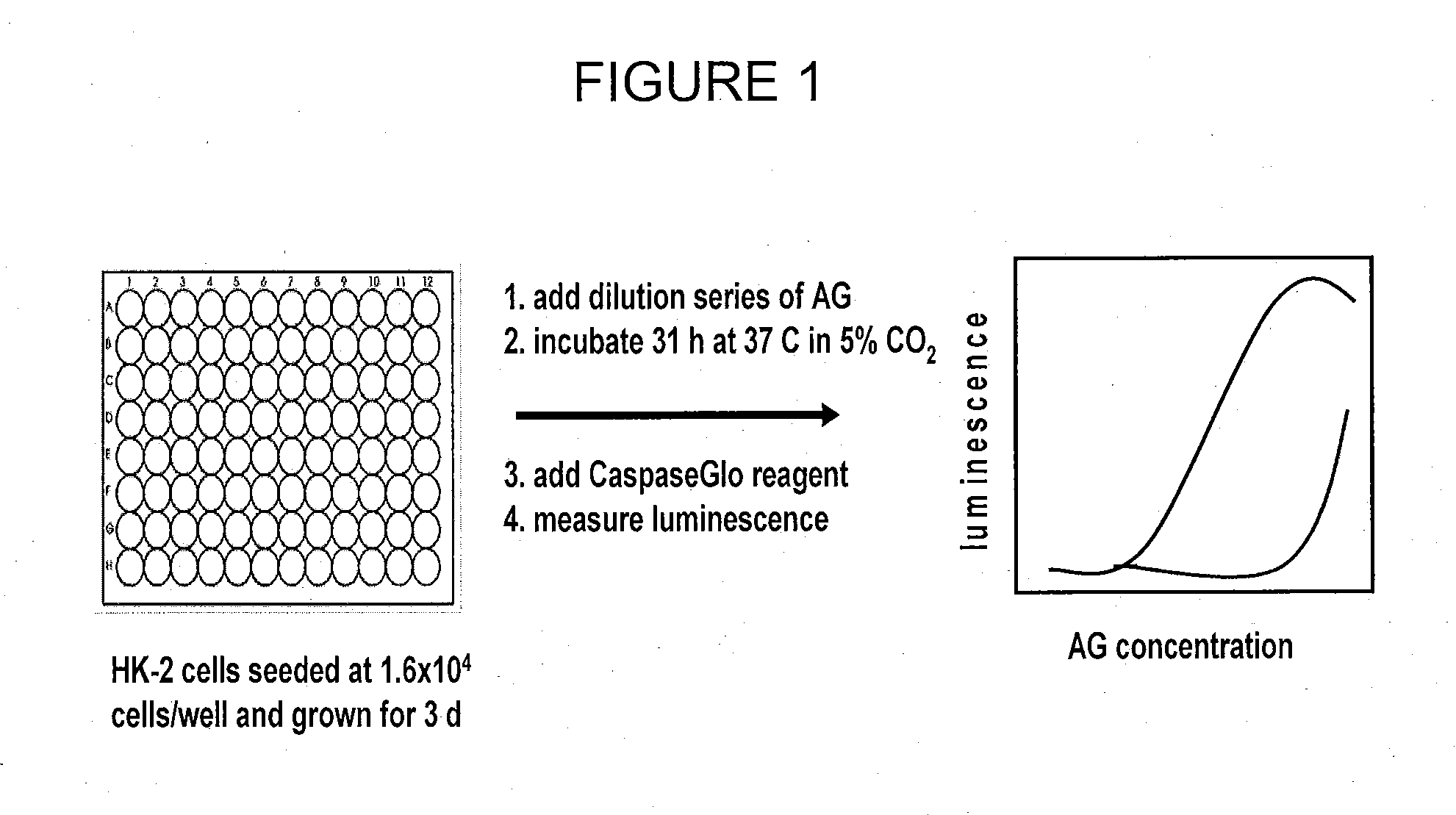Compositions and methods for determining nephrotoxicity
a nephrotoxicity and compound technology, applied in the field of compound nephrotoxicity determining methods, can solve the problems of complex interactions underlying the mechanisms of critical interactions, renal failure, and nephrotoxicity, and achieve the effects of reducing the number of cells and reducing the activity of luciferas
- Summary
- Abstract
- Description
- Claims
- Application Information
AI Technical Summary
Benefits of technology
Problems solved by technology
Method used
Image
Examples
example 1
HK-2 Nephrotoxicity Assay
[0151]An in vitro nephrotoxicity assay was conducted using the human kidney epithelial cell line, HK-2. An overview of the HK-2 nephrotoxicity assay protocol is shown in FIG. 1.
[0152]HK-2 cells were cultured in KSFM, with 5 ng / mL epidermal growth factor (EGF) and 0.05 mg / mL bovine pituitary extract (BPE). Cells were maintained at sub-confluence and used to initiate the assay when they reached 80% confluence. HK-2 cells were harvested using trypsin-EDTA and dispensed into the wells of a 96-well polystyrene tissue-culture plate at a density of 1.6×104 cells / well in a final volume of 100 uL / well. Plates were incubated at 37° C. with 5% CO2 for 3 days.
[0153]Compounds to be tested were diluted in KSFM with 10 mM HEPES buffer that had been pre-warmed to 37° C. Plates were removed from the incubator and the media was removed using a multichannel aspirator. Diluted compounds were added to plates. The plates were subsequently returned to the incubator overnight.
[0154...
example 2
Correlation of In Vitro HK-2 Assay with In Vivo Nephrotoxicity
[0158]To validate the utility of the HK-2 assay described in Example 1, the nephrotoxicity of four commercial aminoglycoside antibiotics (amikacin, gentamicin, neomycin and apramycin) and two other test compounds (compounds A and B) were tested using both the in vitro HK-2 assay and a 14-day rat nephrotoxicity model. The rat in vivo assays provided information in the form of acute toxicity, changes in Blood Urea Nitrogen (BUN) and serum creatinine levels over time, as well as histopathology changes in the kidneys of animals sacrificed at the end of the study. Elevation in BUN or serum creatinine is one of the markers routinely monitored in the clinic as an indication of aminoglycoside nephrotoxicity.
[0159]These studies demonstrated a significant correlation between the results from the in vitro HK-2 assay and the in vivo results obtained from the 14-day rat nephrotoxicity model. Specifically, it was found that the minimum...
example 3
Correlation of In Vitro LLC-PK1 Assay with In Vivo Relative Nephrotoxicity
[0161]An in vitro nephrotoxicity assay was conducted using the porcine kidney tubule cell line, LLC-PK1. Assays are conducted essentially as described in Example 6, but with the modifications.
[0162]On Day 1 of the experiment, LLC-PK1 cells that had been maintained in low glucose DMEM with 5% FBS were trypsinized and re-seeded at a density of 8×103 cell / well in the wells of a 96-well polystyrene tissue-culture plate. Plates were incubated at 37° C. with 5% CO2 for 3 days.
[0163]On day 4, compounds to be tested were diluted in Ultraculture medium (Cambrex) containing 2 mM L-glutamine and 20 mM HEPES buffer that had been pre-warmed to 37° C. The compounds that were tested were serially diluted from 400 μg / mL to 1 μg / mL. Plates were removed from the incubator and the media was removed using a multichannel aspirator. Cells were washed with Ultraculture medium and then the diluted compounds were added to plates. The ...
PUM
| Property | Measurement | Unit |
|---|---|---|
| concentrations | aaaaa | aaaaa |
| time | aaaaa | aaaaa |
| time | aaaaa | aaaaa |
Abstract
Description
Claims
Application Information
 Login to View More
Login to View More - R&D
- Intellectual Property
- Life Sciences
- Materials
- Tech Scout
- Unparalleled Data Quality
- Higher Quality Content
- 60% Fewer Hallucinations
Browse by: Latest US Patents, China's latest patents, Technical Efficacy Thesaurus, Application Domain, Technology Topic, Popular Technical Reports.
© 2025 PatSnap. All rights reserved.Legal|Privacy policy|Modern Slavery Act Transparency Statement|Sitemap|About US| Contact US: help@patsnap.com



